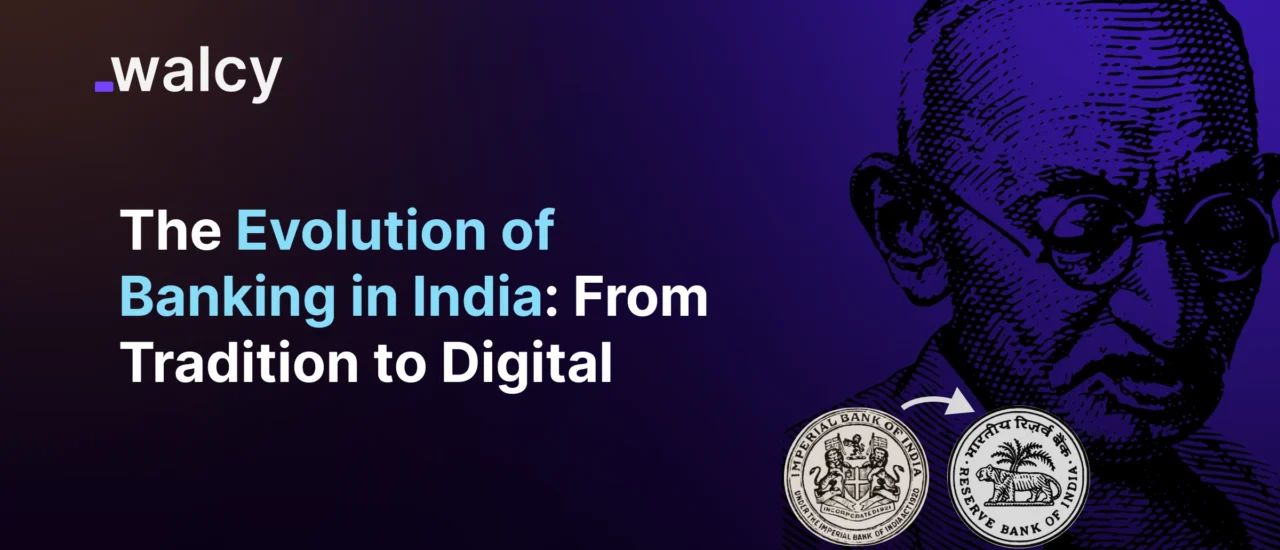The banking industry in India has undergone various metamorphoses for several centuries, rooted in socio-political upheaval, regulatory reforms, and technological changes. The metamorphosis of banking from brick-and-mortar banks to digital banks reflects the progress of the nation toward economic growth.
It would be interesting to trace the evolution of the Indian banking system concerning three broad time-phase gambits, that is, the pre-independence period starting in 1786 up to 1947, post-independence starting in 1947, and the current technological revolution in modern times.
The evolution of banking in India has, therefore, been a function not only of economic demand but also of national policy imperatives and international influences. Whether it was the nationalization of major banks in 1969 to promote financial inclusion, or liberalization in the 1990s that opened doors to private players and foreign banks, each of these phases laid an important foundation for the future.
Today, India is at the threshold of the digital banking revolution, covering recent technologies like artificial intelligence, blockchain, and finch services for smooth, swift, and customer-oriented functioning of banking services. As the country strides forward toward complete digitization and financial inclusion, the banking sector continues as an important partner in achieving Indian aspirations in socio-economic growth.
Pre-Independence Era (1786-1947): The Foundation to evolution of Banking in India.
With origins in the colonial era, India’s financial system existed before the country gained its independence. During this time, the banking system was heavily influenced by British control and catered primarily to urban centers, with little focus on rural or agricultural development.
Early Developments
The General Bank of India thus marked the beginning of India’s formal banking industry in the year 1786. Although it subsequently failed, it provided the necessary foundation for a more structured banking system. The British attempted to institutionalize financial arrangements so that they could support trading activity and provide economic management starting with the founding of the Bank of Calcutta in 1806, which was followed by the Bank of Bombay in 1840 and the Bank of Madras in 1843.
These three banks actively contributed to the accessibility of financial services in cities. An early example of the contemporary banking system, the Imperial Bank of India was established in 1921 as a result of the merger of the banks from the sovereign kingdoms.
This bank played an extremely important role in financing British enterprises in India and was nationalized as the State Bank of India, or SBI, in 1955. Even today, it is the largest public-sector bank in the country. (Sheth, 2023)
The Role of Indigenous Banking
While British-led institutions formed the backbone of formal banking, operating in continuation of them were the Indigenous bankers, known formally as sahukars or moneylenders, providing very important financial services in rural areas. The bankers were deeply embedded in the local economy and provided loans to farmers, traders, and artisans.
They were particularly important in rural areas, where there is little presence of formal banking institutions. Unlike the urban-centered British banks, these money lenders provided customized credit facilities with no strict documentation to the unorganized sectors of the economy (Rajput, 2023).
However, although these bankers demanded high interest rates, their contribution to providing sufficient finance in agriculture and small-scale industries was highly important. They survived in the Indian economy despite competition from the formal banking sector. (Gajdhane, 2023)
Read about: Essential Financial Services for Business | Must Know Things
The Colonial Impact
The British colonial government, through its banking system, served almost exclusively the needs of its economy, while that of India, basically agrarian, remained largely unattended. Banks established during this period were concentrated in urban centers and played a major role in trade, industries, and plantation economies, which were essential to British commercial operations.
Meanwhile, the countryside remained underserved with inadequate agricultural finance. To meet the emerging demand for an increasingly felt need and also with the object of managing the currency and credit system of India, the Reserve Bank of India was established in 1935. The RBI vested the responsibility for issuing currency, exercising control over banking in India, and operating the country’s foreign exchange.
Its establishment did little to improve the stay condition of rural credit, which again was a problem that would be tackled only after independence through reforms and nationalization. (Rajput, 2023)
Post-Independence Era (1947-present): Nation-Building and Reform
After independence, the banking sector played an indispensable role in promoting the economic development of the nation. It was against this backdrop that a series of reforms were undertaken by the government to strengthen the banking system towards promoting industrialization and increasing financial outreach in rural and under-banked areas. These reforms needed to be undertaken to create a strong financial foundation that could support the country’s broader socio-economic objectives.
Pre-Nationalization Era -1947-1969
In the years that followed independence, private banks in India’s banking sector catered more to the urban areas and were profit-oriented. The government thus felt the need to have an all-inclusive banking system that would extend its services to rural India. The major transition occurred in 1955 with the nationalization and rebranding of the Imperial Bank of India as the State Bank of India, or SBI.
This decision came as part of a government plan to spread banking services across rural and semi-urban areas and ensure a greater public-sector presence in the financial system as a whole (Sheth, 2023). During this time, the urban areas continued being ruled by private and foreign banks, considering that most bank branches had been opened in cities, thus leaving the rural areas quite underserved. (Rajput, 2023)
This phase also witnessed the encouragement given by the government for the expansion of bank branches, but the focus remained primarily urban-oriented. Private and foreign banks expanded their operations, and rural penetration remained minimal. This challenge of extending credit and banking services to the rural population was an area of greatest concern and thus set a platform for change in the reforms that followed during the nationalization era. (CiteSeerX., 2023)
Read about: Top Neo banks In India. Everything You Need To Know In 2024.
Nationalization of Banks (1969-1991)
The nationalization of banks in 1969 marked a major turning point in the evolution of the Indian banking system. The government nationalized 14 major private banks, commanding almost 70% of the deposits of Indian banks, as one bold step towards the redistribution of resources for large economic equity.
Such an initiative by the government was expected to extend the services of banking to unbanked and underbanked sections, mainly comprising inaccessible and rural sectors of the country, befitting social equity and financial inclusion. This step changed the whole paradigm of banking from profit-making to developmental service provision: prioritization for agriculture, small-scale industries, and export promotion, amongst others, became imperative.
It was an important change towards ensuring that financial services reached the common people and proved helpful to assist in India’s developmental goals as put forth by (Rajput, 2023) (India, 2008)
This was followed by the second phase of nationalization in 1980, whereby six more private banks came under State control. It was further consolidation in the public ownership of the banking sector so that financial inclusion and equality in different regions and sectors would be promoted (Sheth, 2023).
The formation of the National Bank for Agriculture and Rural Development in 1982 brought to sharp focus this new look towards rural economy and finance for agriculture and rural development. NABARD was playing its role in a big way, while disbursement of funds took place in key sectors and banking facilities reached even the remotest area of the country.
In other words, the era of nationalization marked a serious beginning of social banking with an emphasis on financial inclusion and rural development rather than merely profitability. (CiteSeerX., 2023)
Liberalization and Post-Reforms Period (1991-Present): Competition and Modernization
The liberalization measures after the economic crisis in 1991 transformed the banking environment in India into a more competitive and technologically advanced one. It was for a new era in this regard, efficiencies, innovations, and customer-friendly services were the guaranteed outcome of these reforms.
Entry of Private Sector Banks:
In the post-1991 period, private sector banks like HDFC, ICICI, and Axis Bank entered. These introduced the latest banking technologies, better customer service, and new products like personalized loans and wealth management services. It was a transformation towards competitive and modern banking. (Rajput, 2023)(India, 2008)
Foreign Banks:
The opening up of the banking sector opened the entry even for foreign banks like Citibank, HSBC, and Standard Chartered. These banks inducted global standards and practices into Indian banking that compelled the domestic banks to shape up on efficiency, consumer service, and product offering (Sheth, 2023). Entry of these banks also introduced 24/7 banking, wealth management services, and international banking cards. (Ghosh, 2020)
Technological advances:
The liberalization era revolutionized Indian banking in the form of technological advances. The concepts of ATMs, credit and debit cards, and online and mobile banking restructured the way of offering banking services. Convenience factors, efficiency, and customer experience became the main issues that shifted focus to taking banking to the doorstep of the common man.(Sheth, 2023) (Kumar, 2019)
Digital Banking Boom:
Over the last decade, digital banking and fintech changed the face of the banking industry. UPI, digital wallets, and mobile applications such as Google Pay and Paytm introduced a very noticeable change in banking and financial transactions within India, furthering the idea of a cashless economy and making instant, hassle-free payments a reality. (CiteSeerX., 2023)
Read about: The Best Way To Receive International Payments In India
Evolution of Banking Technology in India: From ATMs to Digital Banking
Thus, during the post-liberalization era, technology became a major driver for changing the face of banking in India. The advancement in many technologies improved not only the operational efficiency but also facilitated inclusion in banking. Introduction of ATMs and Core Banking Solutions
Introduction of ATMs and Core Banking Solutions
In the early 2000s, Indian banks began introducing Core Banking Solutions, or CBS, centralizing all banking operations with the ability to connect any number of branches on networks. This allowed for online, real-time transaction processing and better management of customer accounts across the network.
During this period, the number of ATMs increased and provided customers free access to cash withdrawals, balance inquiries, and mini-statements at any time of the day, thus adding to customer convenience and reducing the need to visit a branch. (Reserve Bank of India Annual Reports, 2000)
Internet Banking
In the early 2000s, most of the major banks started introducing Internet banking services in India. The services of internet banking can be availed by the customers sitting at their homes whereby they can operate their accounts, transfer funds, pay their bills, and so on.
Internet banking has alleviated the pressuring demand caused by a large number of customers for appropriate, comfortable banking facilities with minimum branch dependence. (Economic Survey of India, 2005) This is a giant leap in the facilitation and pace of banking.
Mobile Banking and UPI
The reach of mobile banking in India increased at a rapid pace once the use of smartphones became a widespread phenomenon- it allowed its users to conduct anytime and anywhere transactions. Therefore, the introduction of UPI in 2016 marked a watershed moment when it became possible to transfer money instantly and frictionlessly between bank accounts using a mobile phone.
In effect, UPI mandated usage and integration at many apps and payment platforms in general, playing an important role in increasing financial inclusions and simplifying many day-to-day transactions. (Financial Stability Report, 2020)
Evolution of banking in India: The Digital Banking Era (2016-Present)
Digital banking introduced the technological revolution in Indian banking. The relative emphasis given by the government to move towards a cashless economy following the demonetization in 2016 accelerated the usage of digital payment platforms.
Unified Payments Interface (UPI)
For example, the introduction of UPI in 2016 by the National Payments Corporation of India made instant peer-to-peer money transfers and payments possible through mobile phones without IFSC codes, bank account numbers, or physical infrastructure. (National Payments Corporation of India (NPCI) Annual Reports, 2016)
Fintech Revolution
Companies like Paytm, PhonePe, and Google Pay used UPI and mobile technology to introduce frictionless financial services. These platforms quickly found widespread use for instant payments, bill payments of several utilities, and even for making small-value purchases from the local Kirana shops, thereby increasing the rate of digital financial inclusion manifold. (India, Financial Stability Report, 2020)
Banking as a Service
Further, the Indian banking sector moved to the Banking-as-a-Service model, where the banks offered APIs to fintech for them to offer customized banking services directly to users. The coming together of traditional banks with fintech startups meant opening new avenues of product innovation. Current Challenges and Opportunities. (Reserve Bank of India Annual Reports, 2023)
Current Challenges and Opportunities
Notwithstanding the improvement, several challenges still beset the banking sector-particularly regarding the crisis of the NPA, the threat of cyber security, and further financial inclusions in rural areas. However, with sustained innovation in technology and reforms in regulations, the banking system in India is aptly placed to overcome these challenges.
Crisis of Non-Performing Assets
The NPA crisis is a significant challenge faced by the Indian Banking system, where huge loans granted become non-performing due to delinquencies in payback. It tests the banks’ financial position, therefore influencing banks’ profitability and credit-issuing capability. Firm regulatory steps, and restructuring of bad assets to improve prospects of recovery, include ways for solution of this NPA problem along with financial soundness.
Threats to Cyber Security
With the expansion of digital banking and fintech services, cyber security threats become crucial. Banks and financial institutions are increasingly becoming targets for cyber-attacks that may jeopardize sensitive customer data and financial transactions. The banking ecosystem needs enhanced cyber security measures, the adoption of advanced technologies, and strict adherence to data protection regulations to help protect them against evolving threats. (National Cyber Security Policy Report, 2020)
Read about: Online Banking Security: A Comprehensive Overview”
Financial Inclusion in Rural Areas
Despite the full impact of technology, deficiencies in infrastructure, together with low financial literacy among the rural population, make financial inclusion a challenge in rural areas. Policies to be instituted include increasing digital literacy, expanding banking infrastructure, and using mobile technology to expand financial services in underserved rural communities. (India, 2008)
Conclusion
In a nutshell, evolution of banking in India is a saga of resilience, reform, and technological advancement that has been continuously adapted to the dynamic needs of the economy-from the nascent sector in the early days of colonization to the post-liberalization reforms and digital revolution of recent years. Core Banking Solutions, Internet and mobile banking, and UPI have redrawn the contours of the banking experience and service delivery in ways unimaginable earlier for users at large.
As India marches into the digital age, the sector stands poised to embark upon a new era of exponential growth along with unprecedented levels of financial inclusion. It has opened up newer vistas for financial services, allowed the reaching out to hitherto under-served populations, and enabled the country’s economic development.
Challenges such as NPAs and cyber security threats notwithstanding, the rapid evolution of banking technology ensures a future wherein millions of Indians will better benefit from increased financial services and avenues for economic activity.



